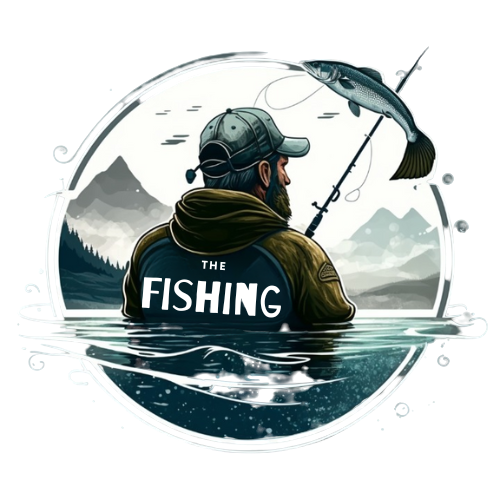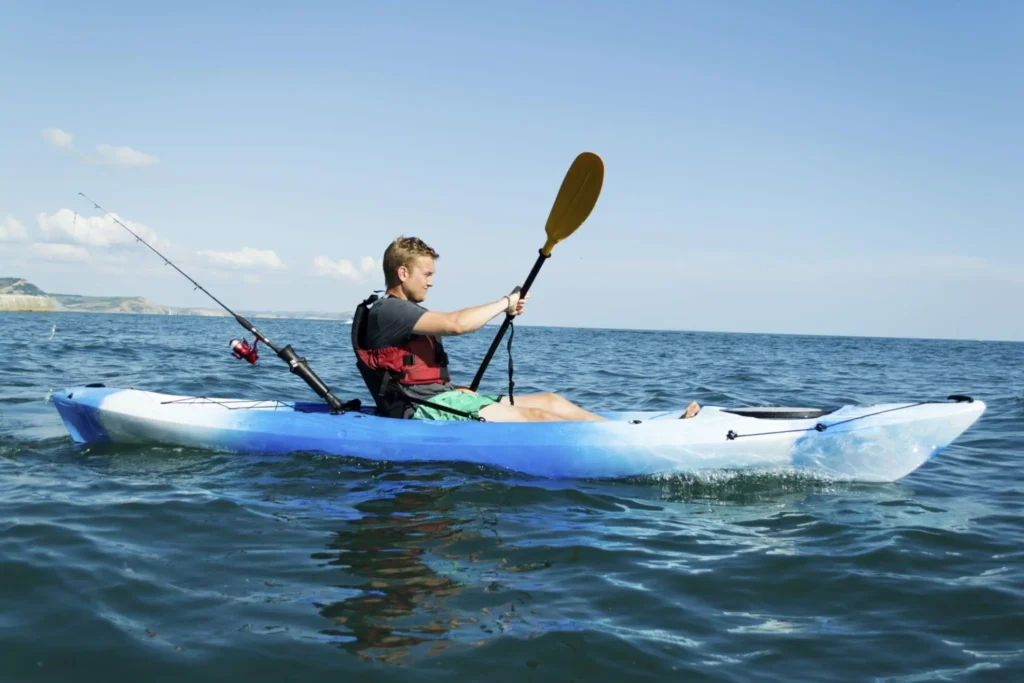
If you’re a fan of the water and enjoy a bit of adventure, chances are you’ve heard of kayak fishing. This exciting sport combines the thrill of fishing with the serenity of kayaking, but before you grab your gear and hit the water, it’s essential to ask the question: is kayak fishing safe?
In this guide, I will delve into the safety aspects of kayak fishing and address common concerns.
Whether you’re an experienced angler or a beginner, understanding the potential risks and how to minimize them is crucial.
So, let’s explore the safety of kayak fishing and what you need to know to stay safe on the water.
Key Takeaways:
- Understanding potential risks and hazards is crucial for safe kayak fishing.
- Proper safety gear, risk assessment, and taking preventative measures can help mitigate risks.
- Always prioritize your safety when planning a kayak fishing trip.
- With the right preparation and precautions, kayak fishing can be enjoyed safely by people of all ages and experience levels.
Table of Contents
Is Kayak Fishing Safe for Seniors?
Yes, kayak fishing can be safe for seniors as long as they take the necessary safety precautions.
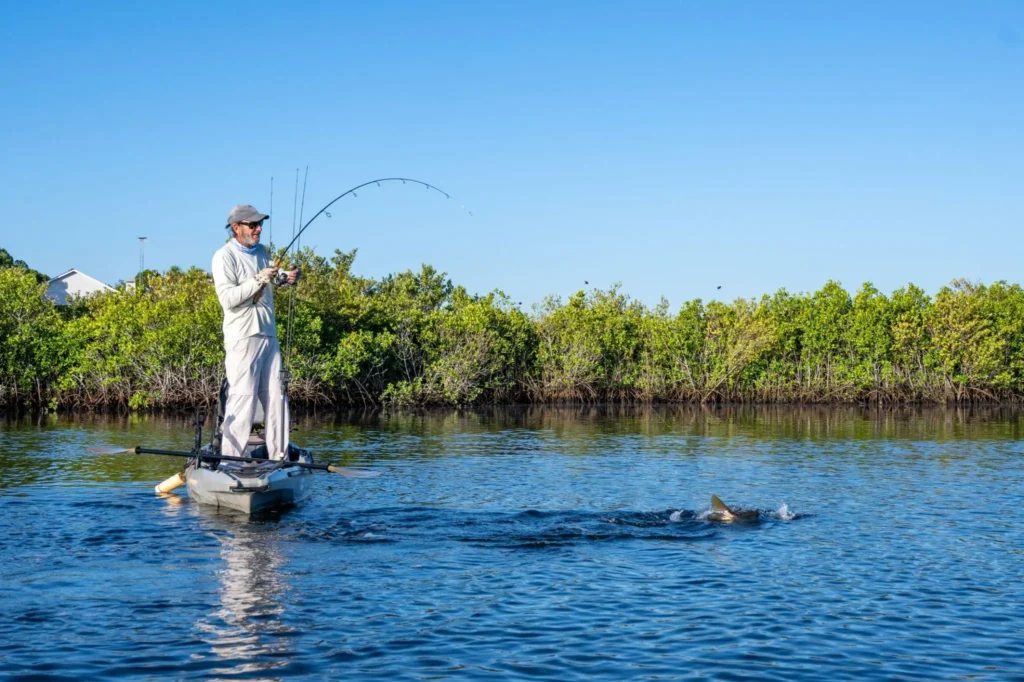
Kayak fishing is a peaceful and exciting sport enjoyed by many, irrespective of age. Thinking about the safety of the elderly who are interested in this sport is crucial. By taking the necessary precautions, seniors can avoid accidents and enjoy this activity safely. Here are some tips to ensure that you are safe while kayak fishing.
Adapting Equipment and Techniques
Seniors should choose kayaks that are comfortable and easy to maneuver.
Sit-on-top kayaks are a good choice because they are stable, easy to get in and out of, and more comfortable.
You can also adapt your paddling techniques to minimize strain on your back and shoulder muscles.
Consider investing in a lightweight paddle with ergonomic handles to make paddling less tiring.
Understanding Physical Limitations
It’s essential to understand your physical limitations, especially if you have pre-existing medical conditions.
Ensure that you have a medical professional’s clearance before engaging in this activity. If you have mobility problems, consider having a safety companion with you.
They can help you launch and dock your kayak and assist with paddling where necessary.
Wearing a Personal Floatation Device (PFD)
Wearing a PFD is crucial, regardless of age.
Choose a PFD that is comfortable, lightweight, and suitable for your body size and weight.
A Coast Guard-approved vest is recommended.
Ensure that your PFD is appropriately fastened before launching your kayak.
Checking Weather Conditions
Always check weather conditions before going kayak fishing.
Avoid going out if there are high winds, storms, or strong currents, as they can make paddling difficult and dangerous.
Pay attention to the weather forecast changes throughout the day as they can be unpredictable.
Knowing Your Limits
Don’t push yourself too hard.
Start your kayak fishing slowly and gradually increase your distance and stamina.
Avoid overexerting yourself or staying out on the water for too long.
Staying Visible
Wearing bright and reflective clothing or attaching reflective tape to your kayak can help make you more visible to larger boats.
It’s also a good idea to carry a whistle or other sound-producing devices to alert others if you are in distress.
Pro tip: If you follow these safety measures, you can enjoy kayak fishing safely. Remember to stay hydrated, take breaks when necessary, and enjoy the peaceful experience that kayaking has to offer.
Is Kayak Fishing Safe While Pregnant?
Yes, Kayak fishing can be done safely during pregnancy as long as proper precautions are taken.
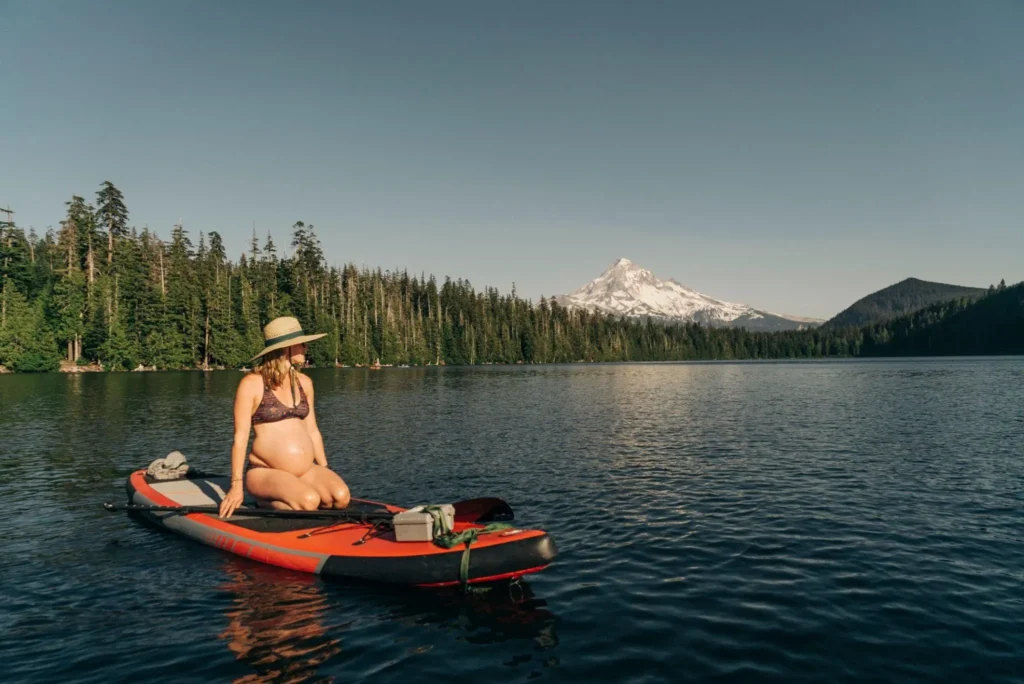
Kayaking is a low-impact activity that allows pregnant women to get exercise without putting too much strain on the body.
Some key points regarding kayak fishing safety while pregnant:
- Wear a properly fitted life jacket at all times. Pregnant women are at higher risk of drowning due to potential immobility, so flotation is essential.
- Use a stable, comfortable kayak designed for fishing. Sit-on-top models provide more security. Consider extra flotation and stability aids.
- Avoid rough water conditions with high waves or strong currents. Paddling should be done in calm, controlled environments.
- Listen to your body’s limits. Don’t overexert yourself, and stay within a comfortable range of motion. Frequent breaks should be taken.
- Check weather forecasts and avoid potentially dangerous storms. Heat and sun exposure also need to be managed carefully.
- Consult your doctor, especially if you have a high-risk pregnancy or medical complications. Get clearance to ensure activity is safe.
- Pack necessary safety gear like communications devices, first aid supplies, and be prepared to call for help if needed.
Safety Tips for Kayak Fishing
Kayak fishing can be a thrilling and rewarding activity, but it’s important to prioritize your safety while out on the water.
If you follow right kayak fishing safety tips, you can minimize your risks and enjoy your time fishing with confidence.
Safe Kayak Fishing Techniques
First and foremost, it’s important to use safe kayak fishing techniques.
This includes learning how to properly launch and land your kayak, how to paddle in various water conditions, and how to handle your gear while on the water.
Take a kayaking course or seek guidance from an experienced kayaker to learn these skills.
Kayaking Precautions for Fishing
Before heading out on your kayak fishing trip, take appropriate precautions.
Check the weather forecast and water conditions, and plan your trip accordingly.
Bring along a personal flotation device (PFD) and other safety gear, such as a whistle, light, and first aid kit.
Let someone know your fishing location and expected return time.
Kayak Fishing Risk Assessment
Knowing how to assess risks is key to staying safe while kayak fishing.
Evaluate your own physical abilities and experience level, and only venture into water conditions and environments that you can handle.
Stay aware of potential hazards such as wildlife encounters, strong currents, and changing weather conditions, and have a plan in place for responding to these situations.
Kayak Fishing Water Safety Precautions
Water safety is paramount in kayak fishing. Always wear a PFD, and make sure it fits properly.
Dress appropriately for the water and weather conditions, including wearing protective clothing and footwear.
Kayak Fishing Precautions
There are additional precautions you can take to stay safe while kayak fishing.
Use a kayak that’s appropriate for fishing, and make sure it’s in good condition.
Carry necessary safety equipment such as a bilge pump, anchor, and paddle float.
Avoid fishing in areas with heavy boat traffic, and be respectful of other fishermen in the area.
By following these kayak fishing safety tips, you can enjoy your fishing trip with peace of mind.
More: How Stable Is A Fishing Kayak? A Closer Look
Importance of Safety Gear in Kayak Fishing
When it comes to kayak fishing, safety should always be a top priority. Investing in the right safety gear not only protects you from potential danger, but it can also enhance your overall experience on the water.
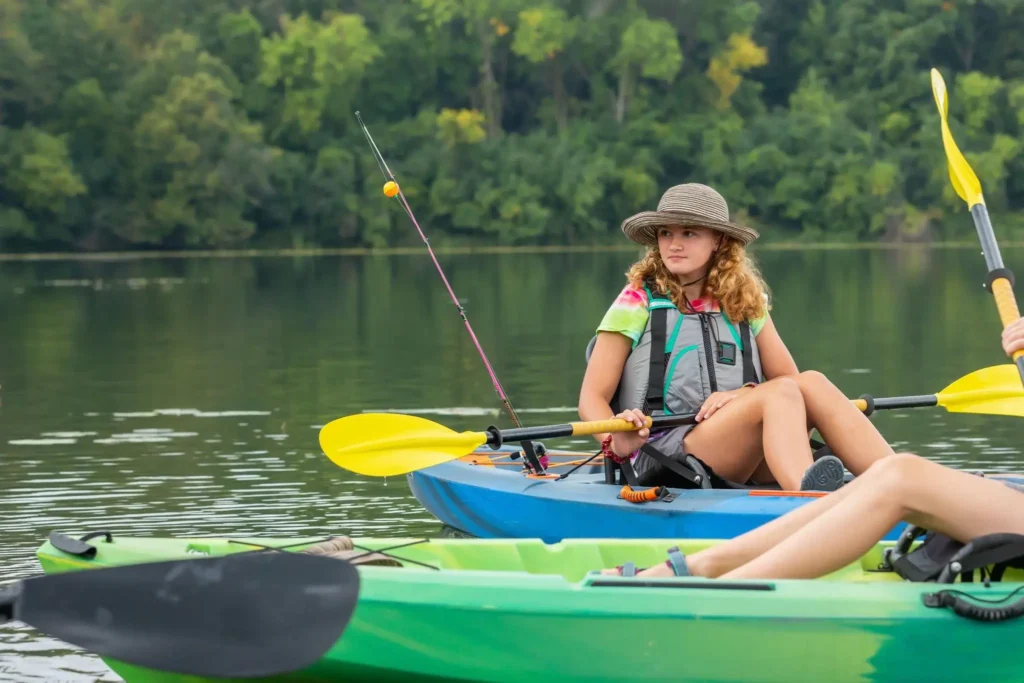
Here are some essential safety gear items to consider for your next kayak fishing trip:
| Safety Gear | Description |
|---|---|
| Personal Flotation Device (PFD) | A PFD is the single most important piece of safety gear for any kayaker. Make sure it fits well and is approved by the United States Coast Guard. It should be worn at all times on the water, regardless of your swimming ability. |
| Communication Devices | Carrying a communication device, such as a waterproof phone case or a marine radio, can be a lifesaver in an emergency. It can also be helpful for communicating with others on the water and keeping in touch with loved ones. |
| Visual Distress Signals | Having visual distress signals, such as flares or reflective tape, can make you more visible to other boaters and can help rescuers locate you in the event of an emergency. |
| First Aid Kit | A basic first aid kit can help you treat minor injuries, such as cuts and scrapes, while on the water. Make sure your kit is waterproof and includes essentials such as bandages, antiseptic, and pain relievers. |
| Navigation Tools | Carrying a map and a compass can help you navigate the water, and a GPS device can provide additional assistance. Be sure to familiarize yourself with the area and any potential hazards before setting out. |
More: Are Fishing Kayaks Good for Rivers? Find Out Here
Kayak Fishing Hazards and Risk Management
As with any outdoor activity, kayak fishing can present its own set of hazards and risks that you need to be aware of.
Being prepared and informed can help reduce the chances of accidents or injuries while on the water.
| Hazards | Risk Management |
|---|---|
| Capsizing | Always wear a personal flotation device (PFD) and take a safety course to learn how to recover from a capsized kayak. Check the weather forecast before heading out and avoid kayaking in rough or choppy waters. |
| Strong currents | Check the current forecast and tide charts before heading out. Avoid kayaking in areas with strong currents or rapids, especially if you are a beginner or not familiar with the area. |
| Wildlife encounters | Be aware of your surroundings and respect the natural habitat of wildlife. Avoid kayaking in areas where wildlife is known to be aggressive. Carry bear spray or other deterrents if paddling in bear territory. |
| Changes in weather | Check the weather forecast before heading out and avoid kayaking in stormy or windy conditions. Bring appropriate clothing and gear to protect yourself from changes in weather. |
| Equipment failure | Inspect your kayak and gear before heading out on the water. Carry spare parts and repair kits in case of equipment failure. |
| Fatigue | Take breaks and stay hydrated during long kayak trips. Know your limits and avoid kayaking in conditions that may cause you to become too fatigued to safely paddle. |
You may like to know: Top 6 Best Fishing Kayaks Under 600: Unbeatable Value!
Conclusion
If you’re new to kayak fishing, you might be wondering whether this activity is safe. While there are potential hazards and risks that come with any outdoor pursuit, there are also plenty of safety measures you can take to ensure an enjoyable and safe experience on the water.
As a beginner’s guide to safe kayak fishing, this article has covered several essential topics to help you stay informed and prepared.
Remember to prioritize your safety above all else, and never hesitate to seek help or advice if you’re unsure about anything.
FAQs:
Is kayak fishing safe?
Yes, kayak fishing can be safe as long as certain precautions are taken. By following safety guidelines, using appropriate equipment, and staying informed about potential hazards, you can enjoy this activity with peace of mind.
Is kayak fishing safe for seniors?
Yes, kayak fishing can be enjoyed by seniors. It is important for older individuals to consider their physical abilities and make adaptations to equipment and techniques to ensure a safe and enjoyable experience.
Is kayak fishing safe while pregnant?
Pregnancy should be approached with caution for any physical activities, including kayak fishing. It’s important to discuss with a healthcare provider and consider potential risks involved. Guidelines can be followed to engage in this activity safely while pregnant.
What are some safety tips for kayak fishing?
Here are some essential safety tips for kayak fishing: wear a life jacket, choose the right kayak, carry safety gear such as a whistle and a first aid kit, be aware of weather conditions, know your limits, and stay visible to other watercraft.
What safety gear is important for kayak fishing?
Safety gear is crucial for kayak fishing. It includes items like a personal flotation device (PFD), a whistle, a communication device, and a first aid kit. It’s important to have the necessary equipment to ensure your safety on the water.
hat are the hazards of kayak fishing and how can they be managed?
Kayak fishing has its own set of potential hazards such as capsizing, strong currents, and wildlife encounters. It’s important to assess risks and manage them effectively. By staying informed and prepared, you can minimize these hazards and have a safer experience on the water.
